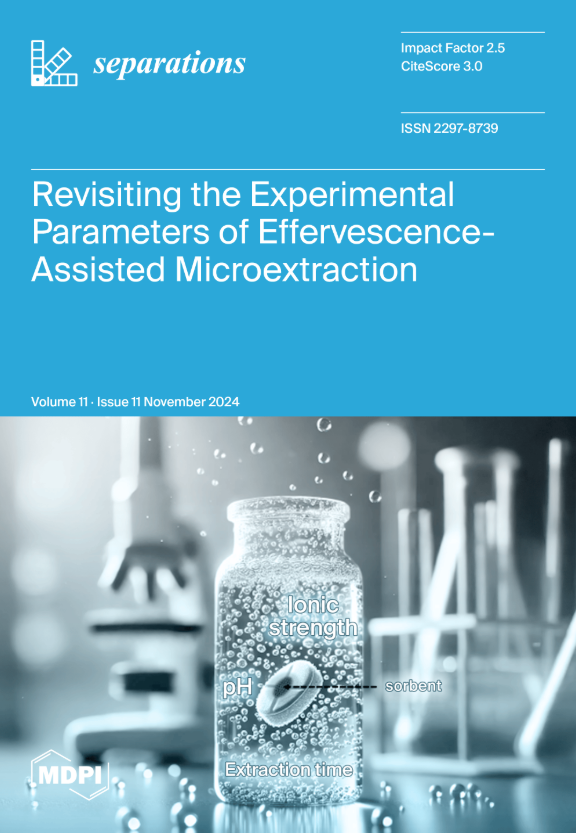糙米中的莫米内酯和酚类物质:富集、优化提取以及抗氧化和抗糖尿病活性的潜力
IF 2.7
4区 工程技术
Q3 CHEMISTRY, ANALYTICAL
引用次数: 0
摘要
这是第一项旨在通过蒸煮过程富集发芽糙米(GBR)和非 GBR 变种越光糙米(Koshihikari)及牛奶皇后糙米(Milky Queen)中的莫米内酯 A(MA)和 B(MB)以及酚类化合物的研究。对这些化合物的提取方法进行了优化,采用了各种条件,包括溶剂(80% 甲醇和 80%乙醇)、加热(80 °C)和超声(2 小时)。超高效液相色谱-电喷雾质谱法(UPLC-ESI-MS)和高效液相色谱法(HPLC)分别测定了桃内酯和酚类物质的含量。结果表明,使用 80% 甲醇和超声波处理的越光 GBR 熟提取物(GKB4)中三酸、咖啡酸、ρ-羟基苯甲酸、ρ-香豆酸、阿魏酸、水杨酸和肉桂酸的含量最高(1.71、1.01、0.62、0.45、0.94、2.50 和 0.37 毫克/克 DW),这与 DPPH 和 ABTS 试验中最强的抗自由基活性(IC50 分别为 1.47 和 1.70 毫克/毫升)一致。使用 80% 乙醇和超声处理的非蒸煮 GBR 越光提取物(GKB9)显示出最高的 MA 和 MB 含量(分别为 147.73 和 118.8 μg/g DW)。值得注意的是,与抗糖尿病药物阿卡波糖(IC50 分别为 0.26 和 2.48 毫克/毫升)相比,GKB9 对α-淀粉酶和α-葡萄糖苷酶(IC50 = 0.48 和 0.15 毫克/毫升)有很强的抑制作用。这些发现对开发富含酚类和莫米内酯、有益健康的糙米具有重要意义。本文章由计算机程序翻译,如有差异,请以英文原文为准。
Momilactones and Phenolics in Brown Rice: Enrichment, Optimized Extraction, and Potential for Antioxidant and Anti-Diabetic Activities
This is the first study aiming to enrich momilactones A (MA) and B (MB) and phenolic compounds in germinated brown rice (GBR) and non-GBR var. Koshihikari and Milky Queen through the cooking process. Extraction methods for these compounds were optimized by applying various conditions, including solvents (80% methanol and 80% ethanol), heat (80 °C), and sonication (2 h). Momilactone and phenolic quantities were determined by ultra-performance liquid chromatography–electrospray ionization mass spectrometry (UPLC–ESI-MS) and high-performance liquid chromatography (HPLC), respectively. Accordingly, cooked Koshihikari GBR extract using 80% methanol and sonication (GKB4) revealed the highest amounts of tricin, caffeic, ρ-hydroxybenzoic, ρ-coumaric, ferulic, salicylic, and cinnamic acids (1.71, 1.01, 0.62, 0.45, 0.94, 2.50, and 0.37 mg/g DW, respectively), consistent with the strongest antiradical activities in DPPH and ABTS assays (IC50 = 1.47 and 1.70 mg/mL, respectively). Non-cooked GBR Koshihikari extract using 80% ethanol and sonication (GKB9) exhibited the highest MA and MB contents (147.73 and 118.8 μg/g DW, respectively). Notably, GKB9 showed potent inhibition of α-amylase and α-glucosidase (IC50 = 0.48 and 0.15 mg/mL, respectively), compared with the anti-diabetic drug acarbose (IC50 = 0.26 and 2.48 mg/mL, respectively). The findings hold significant implications for developing phenolic- and momilactone-enriched brown rice with health-beneficial properties.
求助全文
通过发布文献求助,成功后即可免费获取论文全文。
去求助
来源期刊

Separations
Chemistry-Analytical Chemistry
CiteScore
3.00
自引率
15.40%
发文量
342
审稿时长
12 weeks
期刊介绍:
Separations (formerly Chromatography, ISSN 2227-9075, CODEN: CHROBV) provides an advanced forum for separation and purification science and technology in all areas of chemical, biological and physical science. It publishes reviews, regular research papers and communications. Our aim is to encourage scientists to publish their experimental and theoretical results in as much detail as possible. There is no restriction on the length of the papers. The full experimental details must be provided so that the results can be reproduced. There are, in addition, unique features of this journal:
Manuscripts regarding research proposals and research ideas will be particularly welcomed.
Electronic files and software regarding the full details of the calculation and experimental procedure, if unable to be published in a normal way, can be deposited as supplementary material.
Manuscripts concerning summaries and surveys on research cooperation and projects (that are funded by national governments) to give information for a broad field of users.
The scope of the journal includes but is not limited to:
Theory and methodology (theory of separation methods, sample preparation, instrumental and column developments, new separation methodologies, etc.)
Equipment and techniques, novel hyphenated analytical solutions (significantly extended by their combination with spectroscopic methods and in particular, mass spectrometry)
Novel analysis approaches and applications to solve analytical challenges which utilize chromatographic separations as a key step in the overall solution
Computational modelling of separations for the purpose of fundamental understanding and/or chromatographic optimization
 求助内容:
求助内容: 应助结果提醒方式:
应助结果提醒方式:


